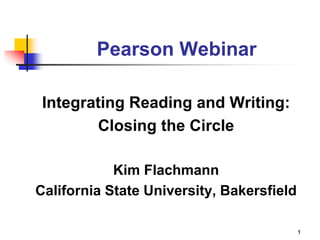
Flachmann pearson-reading-writing-webinar
- 1. Pearson Webinar Integrating Reading and Writing: Closing the Circle Kim Flachmann California State University, Bakersfield 1
- 2. Your Thoughts How do you learn? How are learning and teaching related? How can we all keep improving our teaching? 2
- 3. Reading and Writing Reading and writing are companion activities that engage students in the creation of thought and meaning— either as READERS interpreting a text or as WRITERS constructing one. 3
- 4. Using Reading to Teach Writing and Writing to Teach Reading Students learn how to write by reading: If students DISCOVER for themselves how a reading selection works, they will be more likely to use those discoveries in their own writing. Students learn how to read by writing: If they learn how to look at their writing as READING, they will bring their discovery process full circle. 4
- 5. Making Reading and Writing Interactive The key to this process is DISCOVERY rather than PRESCRIPTION. Helping students discover how to read and write allows them to own their new skills and continue to be good readers and writers long after your course ends. 5
- 7. The Reading Process Prereading Reading Postreading 7
- 8. The Reading/Writing Process Prereading Reading Postreading 8 Prewriting Writing Revising Editing
- 9. Reading Key to College Success The ACT isolated reading complexity as a critical factor by analyzing the results of the 1.2 million high school seniors in 2005 who took the well- known ACT college entrance test. Based on that test, only 51 percent of students showed they were ready to handle the reading requirements of a typical first-year college course. 9
- 10. Ten Strategies that will Change Your Teaching Personal Annotations Think Aloud Chunking Graphic Organizers Peer Teaching Summarizing Critical Annotations Lists Highlighting Reading with the Author/Against the Author10
- 11. Personal Annotations To perform this strategy, make notes in the margin that relate some of your specific memories to the details in your reading. Be prepared to explain the connection between your notes and the facts in the reading. 11
- 12. Think Aloud To do this strategy, stop and “think aloud” about what is on your mind throughout the text. Point out places that are confusing to you, connections that you make, specific questions you have, related information you know, and personal experiences you associate with the text. In this way, you are able to hear what your mind does (both focused and random) as you read. 12
- 13. Chunking To understand how an essay works, circle the main idea or thesis. Then draw horizontal lines throughout the essay to separate the various topics that support the thesis. These lines may or may not coincide with paragraph breaks. Finally, label each “chunk” in the right margin. Be prepared to explain the divisions you made. 13
- 14. Graphic Organizers Your job is to show the relationship of the ideas to one another in a graphic form that makes sense to you. Be prepared to explain your drawing. 14
- 15. Peer Teaching To practice this technique, the class must first divide a reading selection into parts. The class members should then get into groups (one for each part of the essay) and choose one of the essay’s sections to prepare for the rest of the class. After discovering the main ideas, the details, and their relationship to one another, each group should teach its section to the rest of the class. 15
- 16. Summarizing First, identify the main ideas in your reading; then fold them into a paragraph with logical transitions so your sentences flow from one to another. After you write your summary, draft three questions for discussion. 16
- 17. Critical Annotations First, draw a vertical line down the center of a sheet of paper. Then, as you read, write the author’s main ideas on the left and your reactions to those ideas on the right side of the page. Be prepared to explain the connection between your notes and the material in the reading. 17
- 18. Lists After a first reading, divide a sheet of paper into two parts with a vertical line. Then as you read the essay for a second time, record one set of ideas in the left column and related ideas from the essay on the right. Draw lines from one detail to another (if applicable). Be prepared to explain the connection between your lists and the details in the essay. 18
- 19. Highlighting To do this strategy, highlight facts in one color and the author’s opinions in another color. This activity works very well with the next strategy. 19
- 20. Reading with the Author/ Against the Author From the previous highlighting exercise, put an X by any facts or opinions that you do not agree with or want to question in some way. Then record your own thoughts and opinions on a separate sheet of paper. Be prepared to explain any marks you made on the reading. 20
- 22. The Reading/Writing Process READING Reading Strategy Reading 22 WRITING Writing Prompt Writing Revising/Editing
- 23. Application Jot down some notes about a lesson that uses a reading strategy to teach both reading and writing. Wrap your instruction around something you are going to teach. 23
- 24. Integration What professional development plans would you like to help you refresh and invigorate your teaching? 24
- 25. Express Yourself Go to Aimee’s Web site and express your opinions about staying current in your field. What workshops would help you? What venue would you prefer? How often would you participate in professional development? 25
- 26. Let’s Continue Our Conversation I would love to continue our conversation and learn more of your thoughts about reading/writing, about teaching, and about your students. Let me hear from you: kflachmann@csub.edu. Thank you for your time today. 26